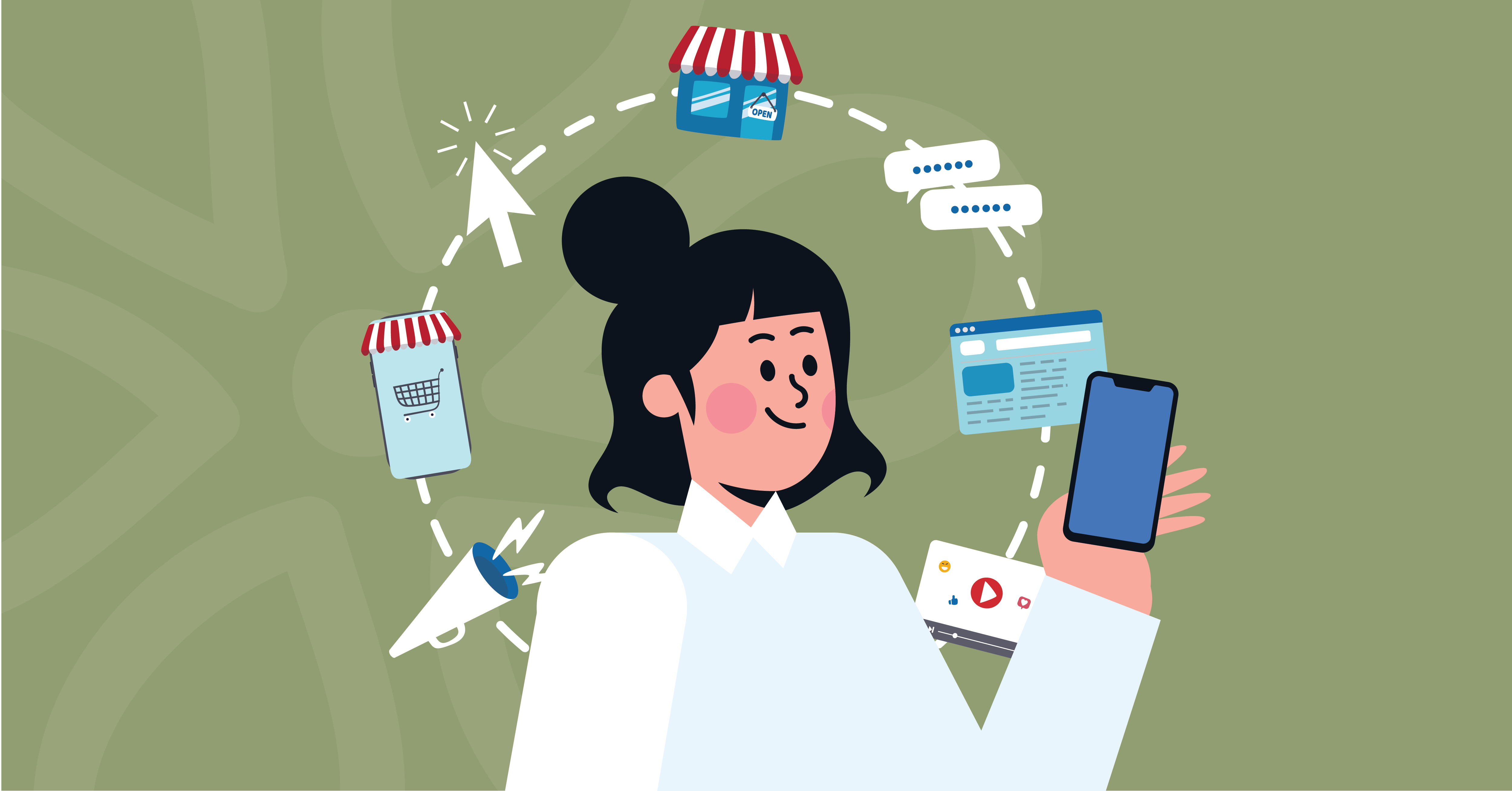First Media presents a glossary of omnichannel marketing terms to help you learn and hone your marketing vocabulary about this important aspect of marketing.
Why is omnichannel marketing so popular? What’s the difference between customer experience and customer journey? How does customer data play into an omnichannel strategy? Learn 13 terms for omnichannel marketing to understand why brands should explore this strategy.
Omnichannel
Definition: Omnichannel is a marketing strategy that creates a cohesive ecosystem of offline and online marketing channels. It’s a customer-centered approach that views every marketing channel as a part of a unified network, generating powerful customer engagement and synchronized data.
Example: Anytime customers have a cohesive interaction with a brand across multiple channels, it’s omnichannel marketing. For example, when a customer sees a retargeting ad on social media about products they’ve explored online or a user receives a follow-up email about items in their cart.
Touchpoints
Definition: Touchpoints are the interactions customers have with a brand. Every time a customer comes into contact with a brand during their customer journey, it’s a touch point.
Example: The ad a customer sees promoting a brand, their visit to the brand’s website, reviews they read, interactions with customer service, adding a product to their cart, commenting on an Instagram post, getting a thank-you email – these are some of the thousands of examples of customer touchpoints.
Customer Experience
Definition: Customer experience is the user’s journey with a business. It’s the summation of all touchpoints throughout the customer journey and how the customer perceives them.
Example: A customer sees an ad online, explores the brand website, and orders a product. After they receive and use the product, they are sent a feedback survey, comment back and forth with the brand on social media, and order again. The customer experience is how they feel about that relationship and engagement throughout all of those touchpoints.
Customer Journey
Definition: Whereas customer experience talks about how the customer feels about the path to purchase, customer journey refers to the touchpoints themselves.
Example: A customer sees a shoppable post on the Instagram page for First Media’s publishing channel, Blossom. They click on a tag and are taken to the landing page for an unfamiliar brand. From there, they can browse products, add to their cart, and check out, all from their Instagram app. The customer journey is that process – from finding the post to purchasing a product.
E-commerce
Definition: E-commerce (electronic commerce) is the buying or selling of products or services via the internet.
Example: A content creation agency offers marketing services to business owners. The agency produces and publishes content promoting a brand, and the business pays a fee to the agency in return. That financial relationship is e-commerce.
Retention
Definition: Brands work hard to get higher customer retention, or the rate customers stay with or return to a business over time.
Example: Users of one online service have a high-quality customer experience. As a result, many customers continue to pay for and use services over several years. That business has high customer retention.
Customer Engagement
Definition: A business’s relationship with its customers is sometimes called customer engagement. Better customer engagement creates brand loyalty and higher retention. Omnichannel marketing gives a huge advantage in improving customer engagement as it concentrates on the customer experience.
Example: A brand fosters customer engagement via social media, pre- and post-purchase contact, attentive customer service, and feedback requests.
Customer Relationship Management (CRM)
Definition: CRM refers to the process of analyzing and improving customer engagement and the overall customer experience.
Example: There is tons of CRM software available to brands that help gather data, analyze, and enhance customer relationships. It’s also possible for businesses to improve customer relationships with manual attention to the customer journey and experience.
Customer Data
Definition: Customer data is any information gathered about customers of a business. Omnichannel marketing relies heavily on customer data – and uses it incredibly effectively to improve the customer experience and benefit brands. Customer data can be gathered via technologies specifically designed to analyze customers or via manual tactics like surveys, social media, and more.
Example: First Media uses proprietary technologies to gather and utilize customer data. For example, our Comment Analysis Tool (CAT) combs through comments made on organic social posts to pull out key takeaways that can be used to give insight into our partners.
Customer-Centric
Definition: Customer-centric marketing focuses on the customer – their interests, needs, behavior, pain points, and experiences. Omnichannel is a customer-centric style of marketing.
Example: Omnichannel marketing emphasizes how the customer experiences their journey, concentrating on how customers receive the messages they see. For example, one customer-centric tactic is sending users emails about abandoned carts. This and other customer-centric approaches focus on enhancing the overall experience.
Metrics
Definition: Metrics quantify or measure the performance and effectiveness of marketing campaigns.
Example: Some common omnichannel metrics are customer lifetime value, customer satisfaction, social media engagement metrics, and churn rate.
Brand experience
Definition: Like customer experience, brand experience is the opinion users have about a brand throughout all their interactions. Customer experience refers more to the brand-customer relationship, while brand experience explains the brand’s perception.
Example: A partner of First Media improves the customer experience by eliminating pain points throughout the customer journey. Users feel cared for with quality engagement and touchpoints that seamlessly flow across multiple platforms. Due to this positive journey, customers have a positive perception, or brand experience, of the partner.
Offline Channels
Definition: Offline channels are any channels of communication or marketing that happen off of the internet. The best omnichannel marketing attends to both offline and online channels.
Example: TV ads, billboards, radio commercials, trade shows, and cold calling are all offline channels. Public digital signage in malls, restaurants, gas stations, subways, and lobbies or elevators are also excellent offline channels.
Building Successful Omnichannel Marketing with First Media
First Media’s marketing strategy incorporates omnichannel marketing for effective customer engagement across all platforms. Online and out-of-home, First Media’s audience is met with intentional, strategic content that drives action on every channel for a cohesive experience. Find out more about omnichannel marketing and how to use it to drive sales and loyalty with First Media.





